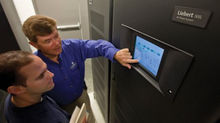Consequence of Dormant Activity in The Control Room
So far we have Identified Immediate Errors, Future Related Errors, Lighting, and Noise, as factors that play a significant role in presenting risk for Control Room operators. Of course, this is only a small pinch to the myriad of concerns one must consider when designing a Command Center soup-to-nuts. But we do hope this helps bring focus back to what is most important; minimizing risk for operators in their day to day operations.
In this blog we will address how Mental and Physical Fatigue can introduce an unforeseen future risk. “Inactivity,” will be the focus of conversation today. When doing less can be exhausting!

Physical and Mental Fatigue in the Control Room
Let’s look back at what we have already discussed. In the first few posts, we spoke about the distractions operators are commonly presented with. Noise, traffic, lighting, etc.…. Now imagine we have identified each one of those potential hazards and have taken the necessary measures to correct them. The plant, pipeline, system or grid is running correctly there are very few surprises and the system seems to quietly ‘run itself’. When we minimize the room noise, eliminate distraction, improve lighting, sightlines and ergonomics, there seems to be nothing working against your operator/controller. Or is there?
“Inactivity – When doing less can be exhausting”
It is common sense to suggest every operator would appreciate an “event free” environment, minimizing risk in a control room. Eliminating the probability for human error is a common goal every team strives to implement. And in order to do so, every factor we have discussed, must be adhered to.
However, an operator in such a situation may be at a disadvantage. Operators are prone to be aware and attentive of operations on a day to day basis. But what happens when they are inactive for too long? Is it possible that a stable, quiet, control room now creates a subliminal craving for sleep? The answer is, absolutely. As with any environment, most humans will feel the urge to sleep, or at bare minimum feel grogginess when remaining stagnant for too long. You then put them in a relaxed, cozy atmosphere, and that urge will only increase. The likelihood of missing crucial information, miscommunicating, or misinterpreting critical components will increase as a consequence. In fact, our partner at Design Matters just recently heard firsthand of such a situation. One of their clients had an alarm go unattended for two hours because an operator appeared to be monitoring the system as he sat in his chair, but in reality he was fighting falling asleep for the duration of that timeframe. We have all encountered that feeling, and no matter what one does, it can seem impossible to break from the trance. The other operator in the room, busy monitoring his own system, never heard, nor never saw the alarm and assumed his partner was on top of things. We should mention too, there was not an audible alarm, which is a major issue all in itself. I love using examples from Design Matters as they can show real life examples of potential risks in a Control Room that can quickly alter from normalcy to catastrophe in the drop of a hat.
Is There an Equilibrium to Designing a Control Room?
So what is the solution? It seems like all we have been doing is pointing out the negativities in a Control Room, and no matter what anyone does, they are setup for failure. Well, in reality that is not the case. The solution really is as simple as common sense. It is not drinking 5 cups of coffee a day, nor is it munching on sugary snacks as an extra source of energy. In actuality, a routine of that nature will present the individual with more frequent slumps and periods of “hitting a wall.” Physical activity is key. Not only will activity help keep an operator alert and focused, but it also allows us to maintain that alertness long after the operators shift has ended. That does not mean you need to go run a mile during every break, it simply means we need to fluctuate our working patterns and refrain from sitting for hours on end. This is why height adjustable tables have become so popular as of late regardless of industry. In fact, there are hundreds of studies that show the health benefits, increased productivity rates etc.…. Do keep in mind, this can be overdone. To maintain one’s highest level of alertness, they simply need to stand for about 10-15 minutes every hour. Being on one’s feet for too long will bring the same results as sitting for too long. So it is all about finding that perfect median, and 10-15 minutes is what has been proven to be the most successful.

Staying Alert in The Control Room
The main thing to keep in mind, is preventing fatigue needs to be proactive. Waiting until we have already begun dozing off is too late. It is much tougher to combat falling asleep when the body has already decided to shut down. Standing for 10-15 minutes every hour is a great way to be proactive. Exercising periodically during breaks is another great way. As I mentioned earlier, it should not be overdone, but something simple like taking a walk to get the blood flowing again can go a long way.
There are many solutions to combating fatigue, but knowing the potential risks and being proactive is the first step to minimizing disasters.
“When everything is running smoothly, it’s easy for us to let our guard down in ways that we don’t realize. Implement simple tools that will allow operators to be both proactive and reactive in their fight against fatigue!”
Should you ever find yourself wanting to learn more, we are happy to have a conversation around the design phase. You can either visit our website or reach out directly to Cwilson@LegacyDenver.com. As mentioned numerous times, we also partner with Design Matters who is also available and has conducted various national studies around these concepts. They are also more than willing to help. Their website can be found here.







